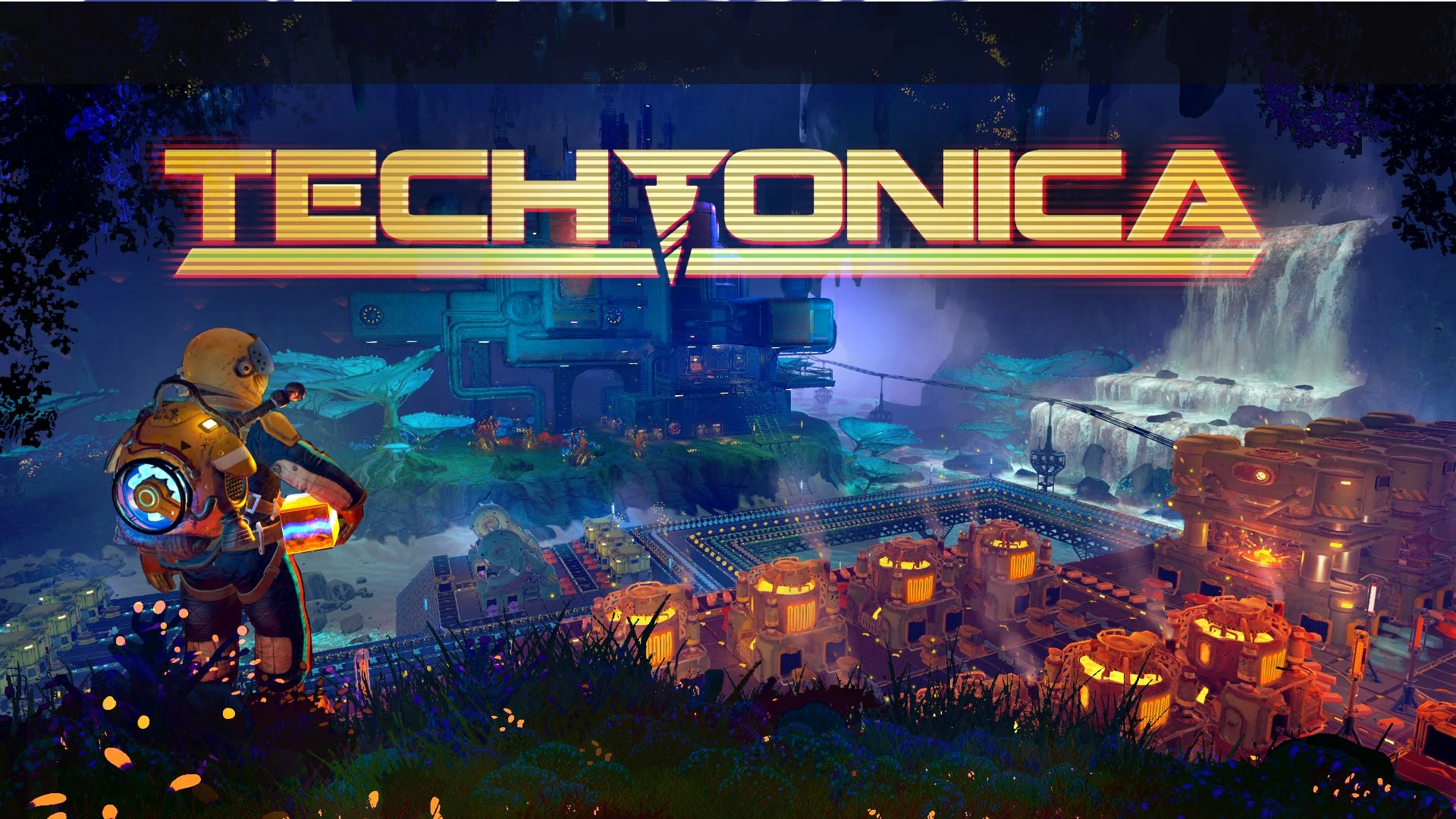Techtonica offers players a chance to explore a world full of discovery and innovation. To survive and succeed in this game, players must learn to use alien technology. They will explore large landscapes, collect resources, craft tools, and uncover the secrets of an unknown planet. At the start, players focus on gathering and crafting, which are essential skills for their progress. As they move forward in Techtonica, they will encounter more difficult tasks that require smart automation and strategic planning. Success relies on creating efficient production lines and exploring the technology trees to improve their base with new technologies and research paths.
Techtonica is also a non-profit organization dedicated to helping women and non-binary adults succeed in the tech industry. Their free, intensive program combines a strong curriculum with professional development workshops. It creates a supportive community where participants can learn and grow. This article outlines the Techtonica curriculum, focusing on the important technologies covered and the benefits of the program. We will look at the four phases of the program, from basic web development to full-stack application development. Whether you are interested in coding or considering a career change, this guide gives valuable insights into Techtonica’s program and how it can lead to a rewarding tech career.
Navigating the Techtonica Curriculum
Techtonica is a non-profit organization that offers free tech training and job placement assistance to women and non-binary adults in need. Their program is designed to help individuals overcome barriers to entering the tech industry and launch successful careers as software engineers.
The Techtonica program is full-time and remote. It includes a 5-month intensive curriculum covering various technical skills, as well as professional development workshops to prepare for job searching and career advancement.
Curriculum Overview
The Techtonica curriculum is divided into four phases:
- Fundamentals: This phase covers the basics of web development, including HTML, CSS, JavaScript, and command line.
- Front-End Development: Students learn to build interactive user interfaces with React, a popular JavaScript library.
- Back-End Development: This phase introduces server-side programming with Node.js and databases.
- Full-Stack Development: Students combine their front-end and back-end skills to build complete web applications.
Technologies Covered
| Technology | Description |
|---|---|
| HTML | The foundation of all web pages. |
| CSS | Used to style the look and feel of web pages. |
| JavaScript | Adds interactivity and dynamic behavior to websites. |
| Command Line | A text-based interface for interacting with your computer. |
| Git & GitHub | Tools for version control and collaboration. |
| React | A JavaScript library for building user interfaces. |
| Node.js | A JavaScript runtime environment for server-side programming. |
| Databases (PostgreSQL) | Used to store and manage data for web applications. |
| Testing | Learn how to write tests to ensure code quality. |
| Data Structures & Algorithms | Fundamental computer science concepts important for problem-solving and software development. |
Professional Development
In addition to technical skills, Techtonica provides professional development workshops to help students succeed in their job search and careers. These workshops cover topics such as:
- Resume and cover letter writing
- Interviewing skills
- Networking
- Salary negotiation
- Workplace communication
Is Techtonica Right for You?
Techtonica is a great option for individuals who are:
- Passionate about technology and eager to learn.
- Dedicated to putting in the work required to succeed.
- Able to thrive in a remote learning environment.
- Looking for a supportive community to help them on their journey.
If you are a woman or non-binary adult facing barriers to entering the tech industry, Techtonica can provide you with the skills, support, and resources you need to launch a successful career in software engineering.
Adjacent Topic: Other Resources for Women in Tech
While Techtonica offers a comprehensive program, there are other valuable resources available for women and non-binary individuals pursuing careers in technology. Some of these include:
- Girls Who Code: This organization offers after-school programs and summer camps to introduce girls to computer science.
- Black Girls Code: This organization provides coding workshops and mentorship opportunities for Black girls.
- Ada Developers Academy: This non-profit offers a year-long, tuition-free coding program for women and gender-expansive adults.
- Grace Hopper Celebration: This is the world’s largest gathering of women technologists.
- AnitaB.org: This organization provides resources and support for women in computing.
- Online Communities: There are many online communities, such as Women Who Code and Girl Develop It, that offer support, networking opportunities, and resources for women in tech.
These resources can provide additional support, networking opportunities, and learning experiences for individuals looking to break into the tech industry.
Tips and Strategies for Success in Techtonica
Techtonica is a fascinating and complex automation and mining game. It can be a bit overwhelming for beginners to jump right in and get started. Here’s a comprehensive walkthrough with tips to help you become a Techtonica expert:
Getting Started
- Exploration: Take some time exploring your immediate surroundings. Scattered orange chests contain valuable resources.
- Initial Objectives: Follow the early-game objectives to set up basic iron and copper mining operations.
- Scanning: Use your scanner consistently. Scan plants for info and broken machines for tech tree fragments.
- Deconstruction: Deconstruct unneeded buildings and machines to recover all materials for reuse.
Mining and Processing
- Resource Focus: Initially, target iron and copper ore – these are foundational to your progression.
- Efficient Mining: Place multiple mining drills around resource nodes, ensuring optimal extraction rates.
- Smelters: Build smelters to turn raw ore into usable ingots. Don’t forget fuel (plant matter or bio bricks).
- Storage: Have adequate storage to house resources. Later in the game, you’ll unlock more advanced storage options.
Automation Basics
- Conveyor Belts: These are the backbone of efficient automation, transporting resources between different structures.
- Inserters: Place inserters to help transfer items onto and off of conveyor belts.
- Simple Lines: Start by building simple automation lines. For instance, a conveyor transporting iron from mining drills to smelters.
The Tech Tree
- Research Cores: These are essential for unlocking new technologies in the Tech Tree (press ‘T’ to access).
- Fragment Collection: Scan broken machines to acquire fragments needed to unlock new upgrades for research.
- Strategic Unlocking: Prioritize the technologies that suit your current needs and play style.
Base Building Tips
- Power Management: Ensure you have enough power generators to keep your base operational. Build power floors to efficiently distribute the generated power.
- Layout Planning: Think ahead about your base layout. Organized bases will lead to more efficient operations in the long run.
- Expansion: Don’t be afraid to expand your base as you progress. This provides space for more advanced automation and structures.
| Feature | Description |
|---|---|
| Mining Drills | Extract raw ore from resource nodes |
| Smelters | Process ore into ingots |
| Conveyor Belts | Transport items between buildings |
| Inserters | Load and unload materials onto conveyors |
| Storage Containers | Hold various resources and items |
| Tech Tree | Access and unlock new technologies |
Key Takeaways
- Players start by mastering basic survival and crafting to progress in the game.
- Effective automation and optimization are crucial for managing more complex operations.
- Advancing through the tech trees unlocks essential upgrades and new research opportunities.
Getting Started
Embarking on your Techtonica adventure begins with understanding the core elements: basic mechanics, navigating the game’s interface, and setting up your first base. Mastering these early steps leads to successful resource collection, crafting, and a thriving factory.
Techtonica Basics
Techtonica invites players to marvel at the art of factory building combined with exploration. A good grasp of the tech tree is fundamental, as it unlocks new technologies and advancements. Know that every craft and construction adds a piece to the intricate puzzle of your growing base.
Navigating the Interface
Keep a close eye on the HUD, where essential information is displayed. The minimap and echosketch map provide a layout of the land, while the compass helps with orientation. Status notifications are vital—they will update you on your base’s needs and any issues that arise.
Setting Up Your First Base
Identify a spot where resources are abundant; soil fertility is a bonus. Start by placing a storage box for your necessities. Make sure to establish a power source, as every machine, like smelters and mining drills, will need it to function.
Resource Collection and Analysis
Use your scanner to detect nearby resources, such as iron veins and copper veins. Analyze the terrain type to determine the optimal placement for drills. Extract materials diligently—managing your inventory carefully as you gather.
Crafting Essentials
In the crafting menu, combine gathered materials to create new items. For starters, process plantmatter into fuel and smelt ores into ingots. Iron and copper ingots can be crafted into a variety of mechanical and electrical components, key for expanding your tech capabilities.
Intermediate Techniques
Moving beyond the basics in Techtonica, players are encouraged to master a variety of intermediate techniques. These strategies are essential for efficient progression and will help maintain a thriving underground operation.
Advanced Resource Gathering
To excel in resource gathering, players should unlock and deploy the Mining Drill, an advanced alternative to the standard pickaxe. It’s faster, covers a larger area, and can be placed over resource veins such as iron ore, copper ore, and limestone. By linking drills to conveyor belts that feed directly into containers, players can establish a steady flow of resources into their base of operations.
Refining Processes
Proper utilization of the Smelter elevates raw materials into usable components. Place a steady supply of plant matter or fragments into the smelter’s fuel slot to keep it operational. Advanced smelting techniques involve setting up multiple smelters, dedicating some to iron ore and others to copper ore. This bifurcation ensures a smooth and continuous refining process.
Building and Upgrading
Players should focus on constructing and upgrading critical buildings such as the Assembler or Cooling Systems to enhance their production efficiency. Expansion also includes placing power floors and crank generators to ensure a consistent power supply. Keeping a log of upgrades via the Production Terminal will maintain clarity and control over the development process.
Inventory and Schematics Management
Efficient management of schematics and inventory is key. As players unlock new items and schematics, they must regularly update their databank. Crates and storage boxes are invaluable for organizing resources. It’s also recommended to frequently check the schematics to keep track of required resources for future builds and upgrades.
Automation and Optimization
In Techtonica, mastering automation and optimization is key to boosting your factory’s efficiency. With the right setup, your mining drills and smelters work in harmony, logistics keep materials flowing, and production scales up smoothly.
Automated Mining and Smelting
To start, automated mining is essential. You’ll want to place mining drills onto deposits of iron ore and copper ore to keep your resource supply steady. Once the ore is extracted, it moves onto conveyor belts, guided by careful placement to ensure a clear path to smelters. Here, ore becomes useful metal bars. Using inserters to feed ore into the smelters and to take bars out is a basic yet effective automation practice.
Example Setup:
- Mining Drill -> Conveyor Belt -> Inserter -> Smelter
Smart Factory Logistics
Getting the logistics right in your factory means thinking ahead. Use containers near crafting areas to serve as buffers, ensuring there’s always a supply of materials on hand. Fast inserters can move items quicker, while long inserters reach items that are further away. Link everything back to a production terminal, such as Production Terminal Victor or Production Terminal Lima, to keep track of your inventory.
Key Logistics Elements:
- Conveyor belts
- Inserters (Fast and Long types)
- Containers for storage
- Production Terminals to monitor production
Production Efficiency
Lastly, production efficiency is all about maximizing output while minimizing waste. This often involves using an assembler which can combine raw materials into more complex products. Planning your factory layout to minimize the distance materials need to travel is vital. Keep an eye on your production terminal to make smart decisions about where to expand or streamline production.
Efficiency Tips:
- Use assemblers for complex crafting.
- Design a layout with minimal transport distance.
- Monitor with a production terminal for informed decisions.
Tech Trees and Research
Tech Trees in Techtonica are essential for progressing through the game as they guide players on how to unlock new technologies and improve their production capabilities. Research is the key to advancement, unlocking the potential of your factory with a variety of new buildings, schematics, and components.
Understanding Tech Trees
Tech Trees can be thought of as a road map for technological development within Techtonica. Players start with basic manufacturing capabilities, like smelters, and need to work their way up to more advanced technologies. The tech tree is structured in tiers, with each new tier offering more sophisticated options for improving production efficiency and capabilities. It’s critical to navigate these tiers smartly to optimize your progress.
Research and Unlocking Technologies
Unlocking new technologies is done through research. You need resources called ‘research cores’ to conduct this research. A notable example is the research core 380nm, known for its purple color, which plays a crucial role in accessing higher tech levels. Each new piece of tech requires a certain number of research cores, and higher tiers, like Basic Science Tier 2 or 3, might require different or more advanced cores.
Schematics and Crafted Components
Schematics are the blueprints needed to craft various components that are vital for your Techtonica journey. They detail the required materials and provide the steps to synthesize these components. To craft them, players must gather the necessary resources, use the schematics in their possession, and then employ facilities such as smelters and assembly machines. As you advance through the tech tree, newer and more complex schematics become available, expanding your production capabilities and allowing you to craft more sophisticated items.
Frequently Asked Questions
Navigating the world of Techtonica requires a good strategy and understanding of the game mechanics. These FAQs aim to provide insights on how to approach different aspects of the game.
What are the optimal strategies for tunneling in Techtonica?
When tunneling, it’s efficient to plan your routes in advance to minimize backtracking. Smelters work quickly, so having a steady flow of resources like Iron Ore from nearby veins is essential. Clear defining paths allows for easier expansion and automation later on.
How can you effectively utilize the monorail system in Techtonica?
The monorail system is your best friend for transporting goods across longer distances. To get the most out of it, set up monorail routes between resource hubs and processing areas. This keeps resources moving swiftly and reduces bottlenecks in your supply chain.
What are some effective tips for power management in Techtonica?
Power management is key to keeping your operations running. Focus on creating an interconnected grid that can distribute power evenly. Using a combination of generators and batteries ensures a stable supply, even when demand fluctuates.
What setups are considered the best for advancing in Techtonica?
The best setups often combine automation with efficient resource gathering. Unlocking new tiers in the game’s tech tree opens up opportunities for advanced setups, including Shiverthorn Processing and Cooling Systems. Automate your supply lines early to pave the way for future advancements.
Where can you find plant matter frames in Techtonica?
Plant matter frames are essential for certain upgrades and can be found near bioluminescent flora in caves. Keep a sharp eye out as you explore since these frames often blend into their surroundings.
How can you contribute and find help on the Techtonica forums and Reddit?
Players looking to contribute can share their experiences and tips on the Techtonica forums and Reddit. Engaging with the community by asking questions and offering help is a great way to learn more about the game and improve your play.







